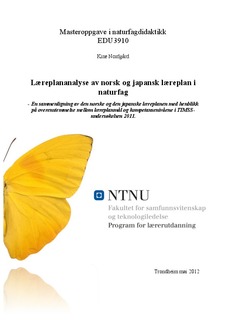| dc.contributor.author | Nordgård, Kine | |
| dc.date.accessioned | 2017-05-16T07:37:38Z | |
| dc.date.available | 2017-05-16T07:37:38Z | |
| dc.date.issued | 2013 | |
| dc.identifier.uri | http://hdl.handle.net/11250/2442571 | |
| dc.description.abstract | Denne masteroppgaven er en analyse av den norske og japanske læreplanen opp mot kompetansenivåer i TIMSS-undersøkelsen fra 2011. Japan skårer høyt i naturfag i internasjonale studier og Norge ligger rundt midten av skalaen. TIMSS (Trends in International Mathematics and Science Study) er en læreplanbasert internasjonal undersøkelse, og denne er utgangspunktet for oppgaven.
Oppgavens problemstilling er: ”Hvordan og i hvilken grad gjenspeiler læreplanene for naturfag i Japan og Norge TIMSS-undersøkelsens kompetansenivåer på høyt og avansert nivå for 4.og 8. trinn ? ”Læreplanene er analysert for å finne i hvilken grad det er samsvar mellom de formuleringer som beskriver de respektive kompetansenivåene i TIMSS-undersøkelsen, og formuleringene av læringsmålene/kompetansemålene i henholdsvis den japanske og den norske læreplanen.
Metoden som er brukt er komparativ casestudie der det først er brukt dokumentanalyse med læreplanen i relasjon til høyt og avansert kompetansenivå for 4. og 8. trinn i TIMSS-undersøkelsen. Deretter er disse to analysene sammenlignet med hverandre, for å se i hvilken grad det er forskjell i overenstemmelsen mellom TIMSS kompetansenivå og målformuleringene i den japanske og norske læreplanen.
Resultater er at kriteriene for høyt og avansert kompetansenivå for 4. og 8. trinn i TIMSS-undersøkelsen i større grad samsvarer med den japanske læreplanen enn den norske læreplanen.
I drøftingen tar jeg for meg andre faktorer som kan ha innvirkning på skårforskjellen som er mellom Norge og Japan. | nb_NO |
| dc.description.abstract | This thesis is an analysis of the Norwegian and Japanese curriculum set against the competency levels of the TIMSS survey from 2011. Japan scores high in science in international studies and Norway scores around the middle of the scale. TIMSS (Trends in International Mathematics and Science Study) is a curriculum-based international survey, and (this is) the starting point for the thesis.
Research questions: "How and in which degree does the curriculum for science, in Japan and Norway, reflect TIMSS survey skills levels on high and advanced levels for 4thand 8th?"The curriculum is analysed to identify in which degree the correlation between the competency levels describing the respective skills levels in TIMSS survey, and formulation of learning goals/competence goals respectively in the Japanese and Norwegian curriculum.
The method used is comparative case study where it first has been used document analysis of curriculum in relation to high and advanced skill level for 4thand 8thgrade in the TIMSS survey. Then these two analyses are compared with each other, to see which grade there is a difference in compliance between TIMSS competency levels and formulation of goals in the Japanese and Norwegian curriculum.
Results are that the criteria for high and advanced skill level for 4th and 8th grade in the TIMSS survey correspond more to the Japanese curriculum than the Norwegian curriculum.
In the discussion, I will discuss other factors that may have an effect on the score difference between Norway and Japan. | nb_NO |
| dc.language.iso | nob | nb_NO |
| dc.publisher | NTNU | nb_NO |
| dc.title | Læreplananalyse av norsk og japansk læreplan i naturfag - En sammenlikning av den norske og den japanske læreplanen med henblikk på overenstemmelse mellom læreplanmål og kompetansenivåene i TIMSS-undersøkelsen 2011 | nb_NO |
| dc.type | Master thesis | nb_NO |
| dc.subject.nsi | VDP::Samfunnsvitenskap: 200::Pedagogiske fag: 280::Fagdidaktikk: 283 | nb_NO |
